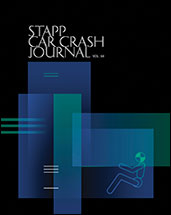2001-06-04
DEVELOPMENT OF AN OCCUPANT POSITION SENSOR SYSTEM TO IMPROVE FRONTAL CRASH PROTECTION 2001-06-0058
In motor vehicle crashes where an occupant has been seriously or fatally injured from a deploying air bag, a common finding has been that the occupant was in close proximity to the air bag (or out-of-position) at the time of deployment. The occupant may have been out-of-position for a variety of reasons including: driver loss of consciousness, pre-impact braking, multiple impacts, rear facing child seat installation, or late firing of the air bag after the occupant has already been forced against the air bag by the crash deceleration. Considerable research has been initiated to develop new or enhanced injury countermeasures to mitigate injuries to persons, particularly children, who are out-of-position at the time of air bag deployment. This paper reports on the development of an occupant position sensor that might be used in conjunction with dual stage or multi-stage inflation technologies for modulating air bag deployment.
The occupant position sensor system described in this paper uses ultrasonic transducers in conjunction with pattern recognition algorithms for the discrimination of out-of-position occupants and rear facing child safety seats. Four ultrasonic transducers operating at 40 kHz, located strategically within the occupant compartment, emit unfocused, wide-beam pulses toward the passenger volume. These pulses are emitted sequentially and each produce return echoes which contain information for discrimination in approximately 10 msec. Thus, the occupant position is updated every 40 msec. The decision algorithm processes the returned information to classify the occupant through the use of a uniquely trained neural network. The logic of the neural network was developed through extensive in-vehicle training with thousands of realistic occupant size and position scenarios. The ultrasonic occupant position sensor can also be used in conjunction with other technologies, (such as weight sensing, seat belt sensing, crash severity sensing, etc.) to feed information to the air bag system’s central processor to govern the deployment decision of the air bag.
SAE MOBILUS
Subscribers can view annotate, and download all of SAE's content. Learn More »
TECHNICAL PAPER
Performance of a Crush Sensor for Use with Automotive Air Bag Systems
920122
TECHNICAL PAPER
Derivation of a Provisional, Age-dependent, AIS2+ Thoracic Risk Curve for the THOR50 Test Dummy via Integration of NASS Cases, PMHS Tests, and Simulation Data
2015-22-0006

BOOK
Stapp Car Crash Journal Vol. 59, 2015
